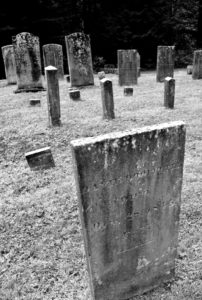A Norfolk Settlement in the Great Greenwoods
Pond Town: A farming and industrial community
By Barbara Perkins
Before Alfredo Taylor was commissioned to design the boat and club houses, before two now well-known bodies of water were dubbed Doolittle and Benedict, even before the first of the magnificent Battells, moved to town, Captain Isaac Holt, one of Norfolk’s earliest settlers, chose land that, according to its deed, “extended eastward from the Highway as far as the Great Pond.” Holt’s selection, followed by those made by the families Benedict, Nettleton, Parritt and many others, marked the beginning of what would become the thriving community of Pond Town.

Familiar names in Norfolk: Pond Town’s cemetery includes headstones for the families of Doolittle and Benedict.
The settlement area is generally identified as lands in the northern portion of town surrounding Great Pond (Doolittle Lake) and Little Pond (Benedict Pond). And, if dates inscribed on headstones at the Pond Town Cemetery are any indication, the community enjoyed nearly 100 years of relative prosperity. Though most of the buildings are no longer standing, thanks to the copious record keeping of early town fathers, much is known about this industrious area.
By way of census records and agricultural inventories, it is known that the area was divided into three different school districts and supported as many schools. By 1800, David Doolittle was operating a grist mill on the outlet of the Great Pond. It is probable that area residents referred to the waters as “Doolittle’s pond” and over time the name stuck. A similar story is attached to the naming of Little Pond. While Doolittle was grinding grain from the neighboring farms, Francis Benedict had a saw mill and cheese box shop on the stream that flowed out of Little Pond.
Pond Town also had its own blacksmith, joiner, tanner and shoemaker. Throughout the first half of the 19th century, lands were still being cleared, more houses were being built and farms were in operation. It wasn’t until the middle of the century that many of the local farmers sold their lands and went west with the prospect of better and larger lots.
Coinciding with the sale of the small farms was a rise in wealth from manufacturing. Also on the rise was the desire to escape the crowded, dirty city to hunt and fish and experience life in the wilderness. Tracts of land were purchased and the area surrounding Doolittle was eventually owned by a handful of families. This consolidation and desire to preserve land for hunting and fishing led to the creation of the syndicate that would become the Doolittle Lake Company.
If you are interested in learning more about Pond Town and its environs, be sure to join Richard Byrne for a guided walk to the Benedict Saw Mill on Saturday September 4. Contact the Norfolk Historical Society for details.
Photo By Barbara Perkins
